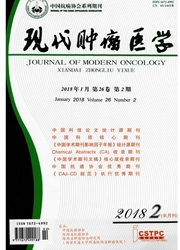

 中文摘要:
中文摘要:
目的:为了降低CT引导下经皮肺穿刺活检的气胸并发症发生率,我们采用了"液性撤退法"。本文初步探讨液性撤退法与同轴法共同应用对于CT引导下经皮肺穿刺活检气胸并发症的减少作用。方法:回顾性分析从2013年1月至2014年12月38例采用同轴法联合液性撤退法进行CT引导下经皮肺穿刺活检的病人,主要研究气胸的发生率。结果:38例肺穿病人中,37例获得明确的病理结果。气胸共发生4例(10.5%),均为轻度气胸,1例操作中发生少量出血(2.6%),6例肺穿后少量痰中带血(15.8%),无感染、针道种植转移或空气栓塞的发生。结论:采用同轴法联合我们首创的液性撤退法,可准确、安全地对肺部病灶进行活检,与单纯应用同轴法比较(气胸发生率30%左右),液性撤退法可显著降低气胸的发生率(10%左右),该方法值得进一步研究和应用。
 英文摘要:
英文摘要:
Objective: To investigate whether our new-developed " liquid withdrawn" technique can reduce incidence of pneumothorax when combined with co-axial technique. Methods: From Jan 2013 to Dec 2014,we studied38 CT-guided percutaneous lung biopsy using co-axial and liquid withdraw techniques. The pneumothorax secondary to biopsy procedure were noted. Pneumothorax was graded as mild,moderate,and severe. Results: Total of 37 cases was diagnosed out of 38 biopsies. 4 cases( 10. 5%) happened pneumothorax( all were mild pneumothorax),bleeding during biopsy happened in 1( 2. 6%) case,6 cases with a small amount of hemoptysis( 15. 8%). No infection,tumor implantation or aeroembolism happened. Conclusion: CT-guided percutaneous lung biopsy using co-axial and liquid withdrawn is an accurate,safe,reliable technique. Compared to co-axial technique without liquid withdraw,the incidence of pneumothorax was reduced from around 30% to around 10%. More studies according to liquid withdraw technique will be conducted in our future work.
 同期刊论文项目
同期刊论文项目
 同项目期刊论文
同项目期刊论文
 期刊信息
期刊信息
